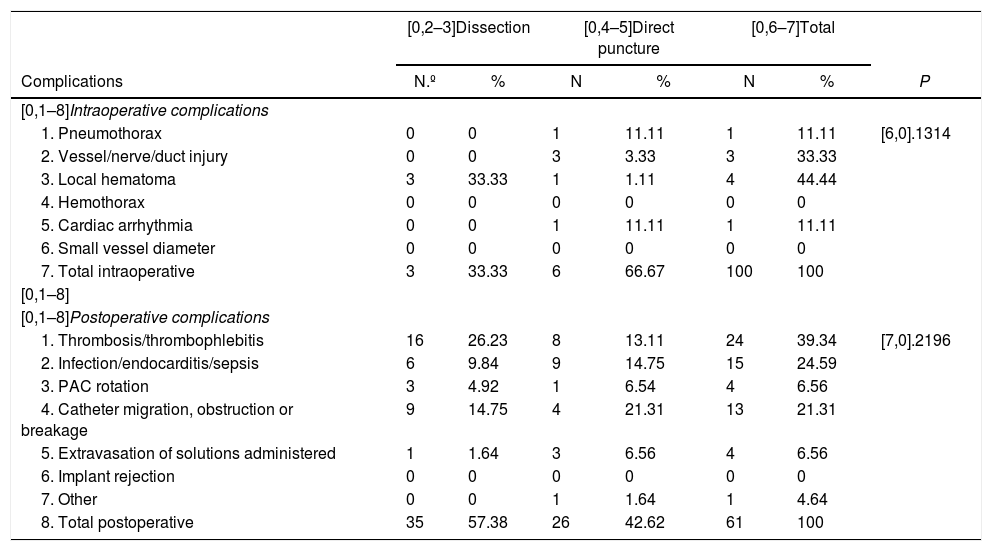There has been an increase in the implantation of subcutaneous reservoirs in recent years. The objective of this study is to compare puncture techniques against venous dissection.
MethodsRetrospective cohort study. It included patients who required a Port-a-Cath. Patients were divided into two groups: venous puncture (PV) and venous dissection (DV). Patients were over 18 years of age, requiring continued intravenous treatment, with no restriction of pathology. We excluded those who had been carrying a previous reservoir, and pediatric patients. The choice of the technique was based on the surgeon's preferences. We analyzed the clinical parameters of age, sex, ASA, BMI, reason for placement and laterality, and data related to the complications and withdrawal rate in each of the groups. The average follow-up was two years.
Results386 patients were included during 5 years: 228 DV group and 155 PV group. In three cases, the technique was not registered. There were no differences between the two groups in age, sex, ASA, BMI and reason for implantation (P > .05). DV presented a lower number of complications, and increased replacement and removal of catheter in PV was observed. Despite this, there were no statistically significant differences (P = .113).
ConclusionsBoth DV and PV are safe and effective techniques. In our experience, DV presented better intraoperative and long-term results. More studies are recommended to discern the technique to be used more safely.
Ha habido un aumento en la implantación de reservorios subcutáneos en los últimos años. El objetivo de este estudio es comparar las técnicas de punción frente a la disección venosa.
MétodosEstudio de cohortes retrospectivo. Incluyó a pacientes que requirieron un Port-A-Cath. Se dividió a los pacientes en dos grupos: punción venosa (PV) y disección venosa (DV). Los pacientes eran mayores de 18 años, requerían tratamiento intravenoso continuado, sin restricciones de patología. Se excluyeron quienes habían sido portadores de un reservorio previo, y pacientes pediátricos. La elección de la técnica se basó en preferencias del cirujano. Se analizaron los parámetros clínicos de edad, sexo, ASA, IMC, motivo de colocación y lateralidad, y los datos referidos a las complicaciones y la tasa de retirada en cada uno de los grupos. El seguimiento medio fue de dos años.
ResultadosFueron incluidos 386 pacientes durante 5 años: 228 grupo DV y 155 grupo PV. En 3 casos la técnica no quedó registrada. No hubo diferencias entre ambos grupos en edad, sexo, ASA, IMC y motivo de implantación p > 0,05. La DV presentó menor cifra de complicaciones y se observó un mayor recambio y retirada de catéter en PV. A pesar de ello no hubo diferencias estadísticamente significativas p = 0,113.
ConclusionesTanto la DV como la PV son técnicas seguras y eficaces. En nuestra experiencia la DV presentó mejores resultados intraoperatorios y a largo plazo. Se recomienda realizar más estudios para discernir la técnica a utilizar con mayor seguridad.











